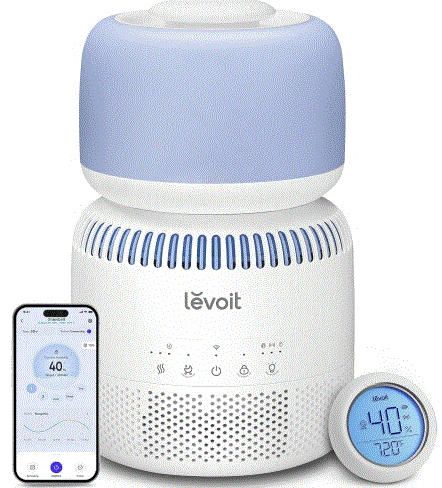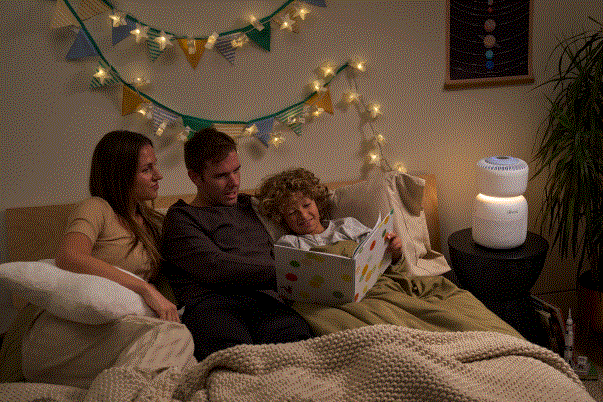Levoit Sprout Evaporative Humidifier

Product Information
Specifications
- Product Name: Healthy Habits for Kids
- Category: Health & Wellness
- Target Audience: Children
Introduction
Ensuring the well-being of our children is a multifaceted endeavor that encompasses physical, emotional, and mental health. By instilling healthy habits early on, we lay the foundation for a lifetime of wellness. This guide delves into science-backed tips, tricks, and essential practices that promote holistic health for kids.
Chapter 1 The Importance of Quality Sleep
Adequate sleep is paramount for a child’s growth, cognitive development, and emotional regulation. Establishing consistent sleep routines can significantly impact their overall health.
Establishing a Bedtime Routine
- Consistency is Key: Set a regular bedtime to help regulate your child’s internal clock.
- Wind-Down Activities: Incorporate calming activities such as reading or gentle stretching before bed.
- Limit Screen Time: Reduce exposure to screens at least an hour before bedtime to prevent disruptions in sleep patterns.
For more detailed sleep strategies, check out these resources:
- Tips to Promote Better Sleep for Kids
- Sleep Strategies for Parents and Kids

Creating an Optimal Sleep Environment
- Comfortable Bedding: Ensure the mattress and pillows are supportive and comfortable.
- Room Ambiance: Maintain a cool, dark, and quiet environment to facilitate restful sleep.
- Air Quality: Utilize air purifiers to maintain clean air, reducing irritants that might disrupt sleep.
Explore the benefits of air purifiers in bedrooms with this comprehensive guide.
Chapter 2 Nutrition and Healthy Eating Habits
A balanced diet fuels a child’s body and mind, supporting growth and learning.
Encouraging a Balanced Diet
- Diverse Food Choices: Introduce a variety of fruits, vegetables, whole grains, and proteins to ensure a range of nutrients.
- Limit Processed Foods: Reduce the intake of ultra-processed foods, which have been linked to a variety of issues in kids.
- Family Meals: Eating together can encourage healthier food choices and foster family bonding.

Involving Kids in Meal Preparation
Engage children in cooking to teach them about nutrition and develop their interest in healthy eating.
- Simple Recipes: Start with easy-to-follow recipes that kids can help with, such as homemade granola or vegetable stir-fries.
- Educational Opportunities: Use cooking time to discuss the benefits of different foods and basic cooking skills.
- Skill Development: Let your kids try out a few kitchen tasks that may seem too advanced, like cracking an egg or loading the dishwasher. You’ll be surprised at how capable they are!
Chapter 3 Physical Activity and Outdoor Play
Regular physical activity is essential for maintaining a healthy weight, building strong bones and muscles, and promoting mental well-being.
Encouraging Active Play
- Daily Exercise: Aim for at least an hour of physical activity each day, incorporating activities like biking, swimming, or playing sports.
- Family Involvement: Participate in active pursuits together, such as hiking or playing catch, to model healthy habits.
Limiting Sedentary Behavior
- Screen Time Management: Set reasonable limits on time spent on electronic devices to encourage more active play.
- Active Alternatives: Provide options like puzzles, board games, or outdoor toys to reduce reliance on screens for entertainment.
Chapter 4 Mental and Emotional Well-Being
Nurturing a child’s mental health is as crucial as their physical health.
Teaching Stress Management
- Mindfulness Practices: Introduce age-appropriate mindfulness exercises, such as deep breathing or guided imagery, to help children manage stress.
- Open Communication: Encourage children to express their feelings and listen attentively to their concerns.
Building Self-Esteem
- Positive Reinforcement: Acknowledge and praise efforts and achievements to boost confidence.
- Encourage Independence: Allow children to make choices and take on responsibilities appropriate for their age.
You can see a list of age-appropriate chores from the American Academy of Pediatrics here.
Chapter 5 Creating a Healthy Home Environment
From regular cleaning to purified air, your home environment plays a significant role in your child’s health.

Maintaining Air Quality
- Regular Cleaning: Keep the home free from dust and irritants through regular cleaning.
- Use of Air Purifiers: Add air purifiers to key spaces to filter out airborne pollutants. Reduced indoor airborne pollutants can improve respiratory health*.
Optimal Humidity Levels
- Humidifiers: Utilize humidifiers to maintain appropriate humidity levels, especially in dry climates and during cold winter months.
- Regular Maintenance: Clean humidifiers regularly to prevent the growth of mold and bacteria.
- Explore the benefits of humidifiers in kids’ rooms with this guide.
- Indoor Air Pollution and Respiratory Health
Chapter 6 Preventing the Spread of Germs and Viruses
Teaching children healthy habits to prevent illness is essential, especially in school and in public.
Hand Hygiene
- Frequent Handwashing: Teach children to wash their hands with soap and water for at least 20 seconds, especially before eating and after using the restroom. Have them sing their ABCs or Twinkle Twinkle Little Star twice to help them hit the 20 second mark.
- Hand Sanitizer: Encourage the use of hand sanitizer when soap and water aren’t available.
Proper Cough and Sneeze Etiquette
- Sneezing into Elbows: Teach kids to sneeze or cough into their elbow instead of their hands to prevent spreading germs.
- Using Tissues: Encourage them to use tissues and dispose of them properly after sneezing or coughing.

Avoiding Touching the Face
Reduce Face-Touching: Explain the importance of keeping hands away from the eyes, nose, and mouth to minimize the risk of infections.
Maintaining Personal Space
- Respecting Boundaries: Teach kids to avoid close contact with sick individuals and practice social distancing when necessary.
- No Sharing of Personal Items: Encourage them not to share utensils, water bottles, or other personal items with classmates.
For more tips on how your kids can put their well-being first, check out this resource.
Conclusion
- Instilling healthy habits in children requires a holistic approach that encompasses quality sleep, balanced nutrition, regular physical activity, emotional support, and a nurturing home environment. By implementing these practices, we can pave the way for our children to lead healthy, fulfilling lives.
- For additional resources and expert advice, explore Levoit’s collection of articles dedicated to promoting well-being for families.
Sources
- https://www.cdc.gov/healthy-weight-growth/tips-parents-caregivers/index.html
- https://www.cdc.gov/child-development/about/index.html
- https://mentalhealthcenterkids.com/blogs/articles/healthy-habits-for-kids
- https://www.scripps.org/news_items/6213-7-healthy-habits-to-teach-your-kids
- https://www.unicefusa.org/what-unicef-does/parenting/teach-children-health-habits
Frequently Asked Questions
- Q: How can I encourage my child to get better quality sleep?
- A: Establish a consistent bedtime routine, create a calming sleep environment, and limit screen time before bed to promote better sleep quality.
- Q: What are some ways to promote healthy eating habits in children?
- A: Encourage a balanced diet with a variety of foods, involve kids in meal preparation, and be a positive role model by making healthy food choices.
- Q: How much physical activity should my child be getting?
- A: Children should engage in at least 60 minutes of physical activity every day, which can include active play, sports, or other physical activities they enjoy.
Documents / Resources
 |
Levoit Sprout Evaporative Humidifier [pdf] User Guide Sprout Evaporative Humidifier, Sprout, Evaporative Humidifier, Humidifier |
